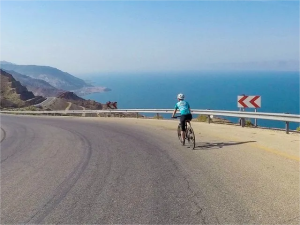Iceland in Canada: Manitoba’s Icelandic Vinarterta Cake and Islendingadagurinn
- by Mohamed Adam

Icelandic culture has a long, rich history in Manitoba’s Interlake region. The Canadian province of Manitoba is located in central Canada, at the eastern end of the Canadian prairies.
In 2014, the Manitoba Icelandic festival ‘Islendingadagurinn’ commemorated 125 years of celebrating Icelandic history, culture, and its contribution to life in the province.
Icelandic Vinarterta, a traditional Iceland celebration cake since 1875, is also woven deep into the fibres of this culture. A culinary time capsule, this incredibly elegant and intricate 7 layered torte, a fragrant symphony of almond, vanilla and fruit filling, has been the belle of the ball at Icelandic Canadian Christmases, birthdays, weddings, special occasion celebrations, as well as dinner parties and even coffee time for well over a century. (See Icelandic vinarterta cake recipe below)
History of the Icelandic Islendingadagurinn Festival
The festival itself, is known to be second oldest continuous ethnic festival in North America. The first Icelandic festival in North America was held in Milwaukee in 1874. The first Icelandic Festival in Manitoba took place in Winnipeg in 1890, but has been held in Gimli since 1932.
The town of Gimli, Manitoba, Norse for “home of the gods”, a haven for settlers who founded New Iceland on the shore of Lake Winnipeg in 1875, is still a welcoming harbor. Perched at the southwestern point of Lake Winnipeg, the largest of Manitoba’s lakes at 24,514-square-kilometre (9,465 sq mi), it is a mere 55 km (34 mi) drive from Manitoba’s capital, and largest city, Winnipeg.
Renowned for its beautiful and natural fresh water lakes and sandy beaches, Manitoba’s Lake Winnipeg and Gimli are meccas for beach goers.
In addition to Viking Village, the festival hosts a FREE daily pancake breakfast, a Viking battle, live entertainment, vendors, fireworks, a midway, all culminating in a parade on the very last day.

And because the heart of Gimli is its waterfront, many of the festival activities take place on the beach. You will find a volleyball competition, sand castle building contest and lots of sunning, swimming and water fun.
As you stroll along the beach and the mural-covered seawall, you can marvel at the view of an inland ocean that stretches to the horizon.

Now on to my favorite part of any festival– the FOOD! Alongside the usual suspects, there is an entire kiosk dedicated to Icelandic Vinarterta, a favoutie of the Iceland desserts. And every imaginable flavor of Vinarterta, the famous Iceland cake, lives here – even Saskatoon berry.
Tips for making Icelandic Christmas Cake
However, since Icelandic Vinarterta, or Icelandic Christmas cake, is traditionally made with a prune filling, you will have fundamentalists of Icelandic food recipes shuddering at the mere mention of any modern incarnations of this traditional fare. So I decided to stick with the classic prune of this Iceland Christmas cake to honour vinarterta history.
But I must warn, the making of this cake is not for the faint of heart. If you are going to attempt this, I would recommend you are, at minimum, an experienced baker. It’s not that it’s “hard” to make, but the Icelandic prune cake is somewhat fussy and time consuming.
Icelandic Vinarterta Recipe
The cake is 7 layers high and therefore the layers are paper thin. Yield: This recipe is for 2 cakes that are 7 inches in diameter.
Course Dessert
Cuisine Canadian, Icelandic
Keyword vinarterta
Ingredients
Cake:
- 1 cup butter
- 11/4 cups white granulated sugar
- 3 Eggs
- 1/2 cup milk
- Dash of salt
- 1 teaspoon almond extract
- 31/2 cups flour sifted
- 11/4 tsp baking powder
Prune Filling:
- 2 pounds pitted prunes
- 2 cups water – water to cover
- 1 1/2 cups granulated sugar
- 1 teaspoon pure vanilla extract
- 1/4 teaspoon salt
- 2 teaspoon ground cardamom
Icing 1- shortening based icing recipe:
- Ingredients:
- 4 Tblsp shortening
- 3 cups of icing sugar
- 2 egg whites
- ½ tsp almond extract
Instructions
Cake:
- Preheat oven to 350 degrees F.
- Cream butter and sugar.
- Add eggs one at a time beating well after each addition.
- Add dry ingredients alternately with milk.
- Add almond extract. Then add up to 2 cups more of sifted flour, but add cautiously. (I only used ½ cup more, but I live in a very dry climate)
- *Dough should not stick to hands.
- Divide dough into 14 pieces and roll out each piece separately.
- Cut each piece into a 7” in diameter round. Aunt Norma uses a pot lid with relatively sharp edges. Most pot sets have a lid this size. I used this and it worked well. It will be very thin.
- Bake rounds on a large cookie sheet covered with parchment paper for 10 minutes. You can do two rounds at one time in a regular oven. I was able to do all 7 for one cake at once in my convection oven
- Let the rounds to cool before handling.
- *If you end up using store-bought prune paste, you need 2 cups of prune paste for each cake. And a teaspoon of cardamom per each 2 cups.
- TIP: Use cornstarch when rolling dough out and on rolling pin (it will not make the dough tough)
Prune filling:
- Combine prunes and water in a medium saucepan. Bring to a boil, reduce heat, and simmer until prunes are tender, about 15 minutes
- Strain, reserving liquid. Coarsely chop prunes in a food processor, and return to saucepan with reserved liquid and the granulated sugar.
- Cook over medium heat until mixture is thick, about 15 minutes. Add vanilla,salt and cardamom.
- Refrigerate until slightly firm, about 30 minutes.
Assembly:
- Start with one round and top it with approx. 3 tablespoons of prune paste.* Do not use ‘heaping’ tablespoons, as I made the mistake of doing this– it’s too much prune. You should only go through 2 cups of paste for 1 cake.
- Add your next round. Again top with 3 tablespoons of paste. When you have added your 7th round, do not put prune paste on top of it.
- Put in a round tin or plastic container and let sit on counter for 3 days in order to cure. The prune paste will soften the rounds.
- Ice the cake with either of the icing recipes (below) after it has cured. Then serve or freeze immediately.
Shortening Based Icing (see Notes for alternative Butter Based Icing)
- Cream shortening and add ½ of sifted icing sugar and cream for 2 minutes.
- Beat egg whites until stiff but not dry. Add to creamed icing sugar/shortening mixture.
- Beat together again, then add almond extract.
- If too stiff, add water (a few drops). If too thin, add a little icing sugar.
- Eat and enjoy! Or freeze for future enjoyment!
Recipe Notes
Icing 2 – Buttercream icing recipe:
Ingredients: 1/4 cup butter (soft)
2 cups sifted icing sugar
2 Tbsp cream
1 tsp each almond and vanilla flavoring
Directions: Blend together the ingredients and spread on cake.
Icelandic culture has a long, rich history in Manitoba’s Interlake region. The Canadian province of Manitoba is located in central Canada, at the eastern end of the Canadian prairies. In 2014, the Manitoba Icelandic festival ‘Islendingadagurinn’ commemorated 125 years of celebrating Icelandic history, culture, and its contribution to life in the province. Icelandic Vinarterta, a traditional…




